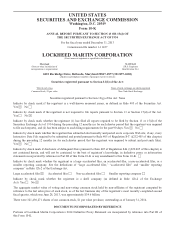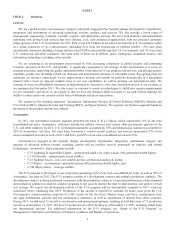Lockheed Martin 2013 Annual Report Download - page 18
Download and view the complete annual report
Please find page 18 of the 2013 Lockheed Martin annual report below. You can navigate through the pages in the report by either clicking on the pages listed below, or by using the keyword search tool below to find specific information within the annual report.The programs in which we participate must compete with other programs and policy imperatives for consideration
during the budget and appropriation process. Concerns about increased deficit spending, along with continued economic
challenges, continue to place pressure on U.S. and international customer budgets. While we believe that our programs are
well aligned with national defense and other priorities, shifts in domestic and international spending and tax policy, changes
in security, defense, and intelligence priorities, the affordability of our products and services, general economic conditions
and developments, and other factors may affect a decision to fund or the level of funding for existing or proposed programs.
The Budget Control Act of 2011 (Budget Control Act) established limits on discretionary spending, which provided for
reductions to planned defense spending of $487 billion over a 10 year period that began with government fiscal year (GFY)
2012 (a U.S. Government fiscal year starts on October 1 and ends on September 30). The Budget Control Act also provided
for additional automatic spending reductions, known as sequestration, which went into effect on March 1, 2013, that would
reduce planned defense spending by another $500 billion over a nine-year period that began in GFY 2013. These additional
spending reductions are arbitrary as they would be applied across-the-board to numerous programs and contracts without
regard to national priorities. While the defense budget will sustain the largest single reduction, other civil agencies and
programs are also impacted by significant spending reductions. In light of the Budget Control Act and deficit reduction
pressures, it is likely that discretionary spending by the U.S. Government will remain constrained for a number of years.
For GFY 2013, which ended on September 30, 2013, sequestration resulted in a $37 billion reduction to the defense
budget in addition to reductions as a result of the discretionary spending limits already imposed under the Budget Control
Act. The impacts of sequestration in GFY 2013 were less than originally expected due to congressional actions that reduced
the cuts as well as the DoD’s ability to allocate a portion of the reductions to prior year unobligated balances and multi-year
investment appropriations. Accordingly, we have experienced minimal impacts to date.
In December 2013, Congress and the Administration enacted the Bipartisan Budget Act of 2013 (Bipartisan Budget
Act). Notably, the Bipartisan Budget Act increased the limits on discretionary spending for GFY 2014 and GFY 2015
imposed by the Budget Control Act, among other fiscal changes. In particular, the Bipartisan Budget Act allows for
approximately $63 billion of additional funding, including approximately $22 billion and $9 billion for defense spending
during GFY 2014 and GFY 2015, respectively, and similar amounts for nondefense programs over the same period. The
revised defense spending limits are set at approximately $520 billion for GFY 2014 and approximately $521 billion for GFY
2015. This agreement allows for more certainty in the budget planning process and provides the DoD the flexibility to better
address its priorities. However, the Bipartisan Budget Act retains the lower spending limits, including the across-the-board
spending reduction methodology, for GFYs 2016 through 2021 as provided for in the Budget Control Act. As a result, there
remains uncertainty regarding how sequester cuts beyond GFY 2015 will be applied as the DoD and other agencies may have
significantly less flexibility regarding how to allocate cuts in future years. While we have not yet seen the specific budget
allocations by program, we continue to believe that our portfolio of products will continue to be well supported in a
strategically focused allocation of budget resources.
While the recent budget actions provide a more measured and strategic approach to addressing the U.S. Government’s
fiscal challenges, sequestration remains a long-term concern. If not further modified, sequestration could have significant
negative impacts on our industry and company in future periods. There may be disruption of ongoing programs, impacts to
our supply chain, contractual actions (including partial or complete terminations), potential facilities closures, and thousands
of personnel reductions across the industry that will severely impact advanced manufacturing operations and engineering
expertise, and accelerate the loss of skills and knowledge. Sequestration, or other budgetary cuts in lieu of sequestration,
could have a material negative effect on our company as would any failure to address issues raised by the debt ceiling.
Additionally, we are seeking to lessen our dependence on contracts with the U.S. Government by focusing on expanding into
adjacent markets close to our core capabilities and growing international sales but may not be successful in this strategy. In
response to continued declines in U.S. Government spending as well as the rapidly changing competitive and economic
landscape, in November 2013 we announced a plan to close and consolidate several of our facilities and reduce our
workforce by approximately 4,000 positions. We expect these facility closures and workforce reductions will be substantially
complete by the middle of 2015; see more information in “Note 2 – Restructuring Charges” of our consolidated financial
statements. Further actions as described above may be necessary in future periods and could result in severance and other
charges that may have an adverse impact on our results of operations. For more information regarding U.S. Government
budget pressures, see “Industry Considerations” in Management’s Discussion and Analysis of Financial Condition and
Results of Operations.
Under such conditions, large or complex programs, which consist of multiple contracts and phases, are potentially
subject to increased scrutiny. Our largest program, the F-35, represented 16% of our total consolidated net sales in 2013, and
is expected to represent a higher percentage of our sales in future years. A decision to cut spending or reduce planned orders
10
























